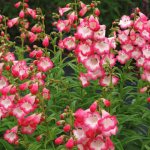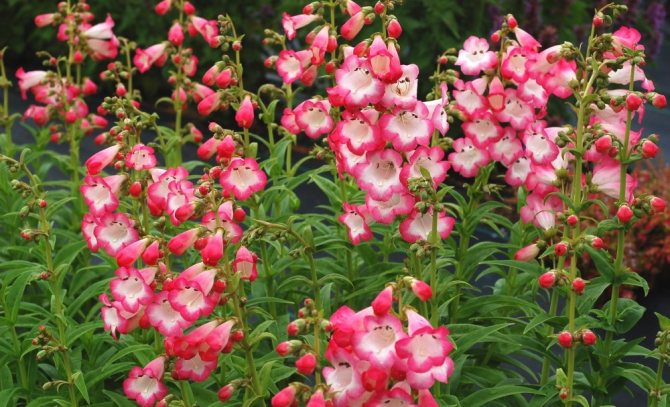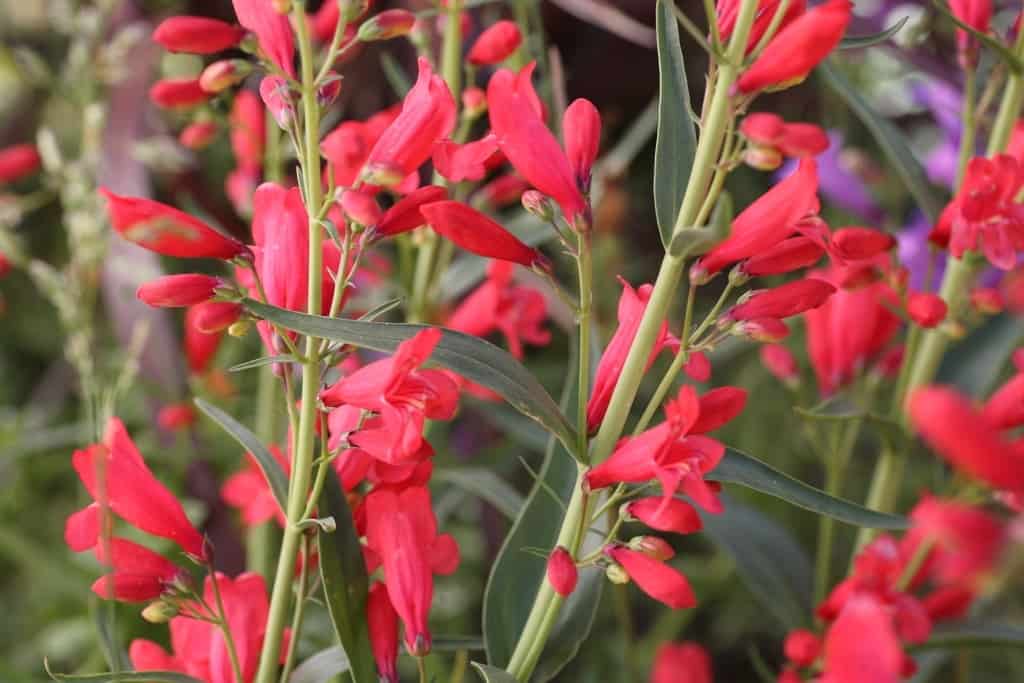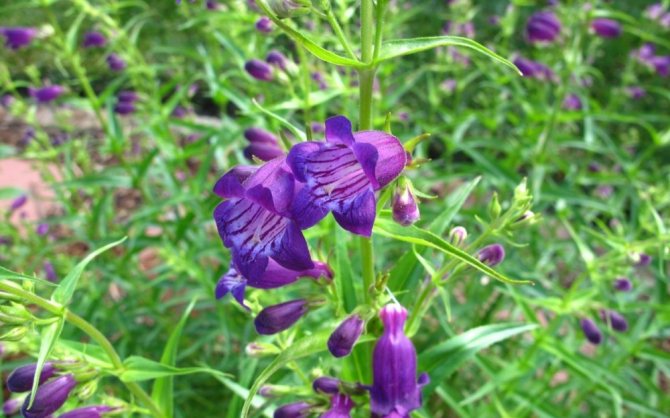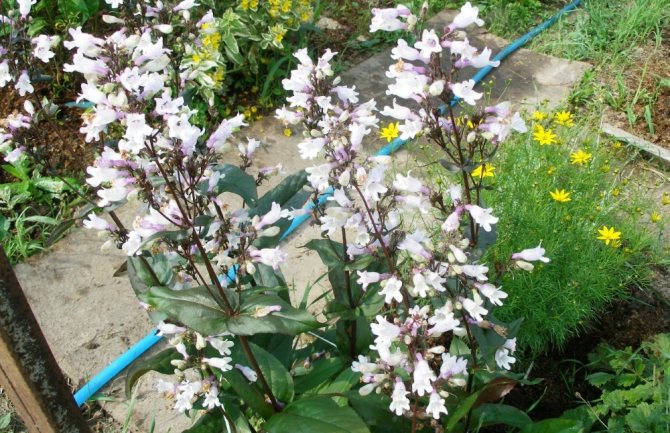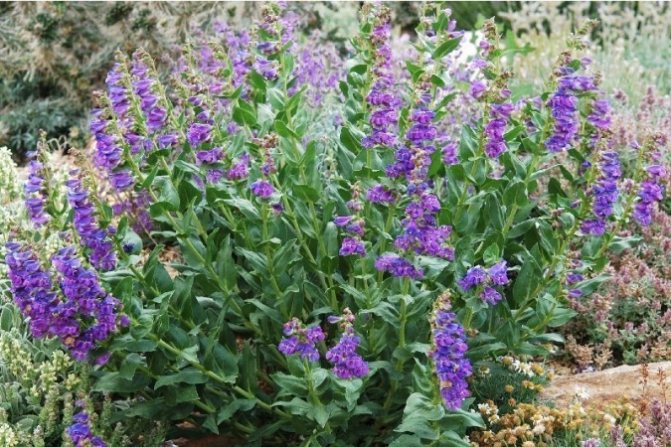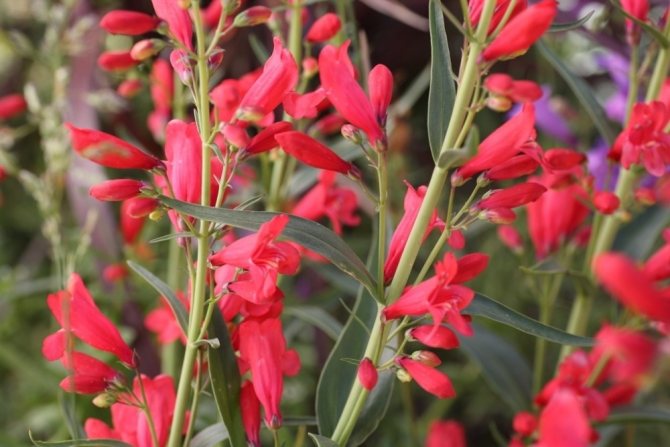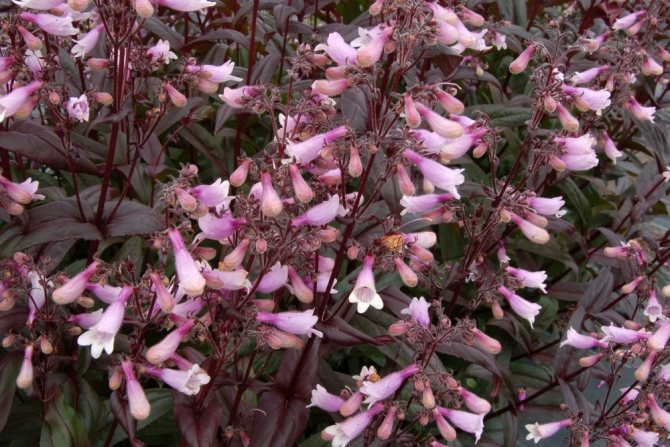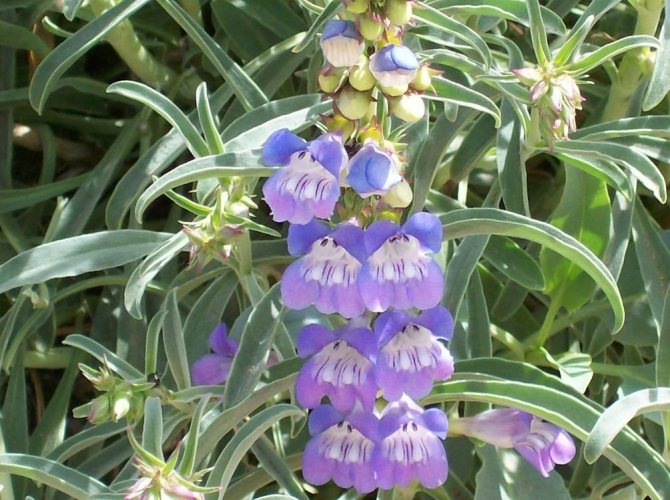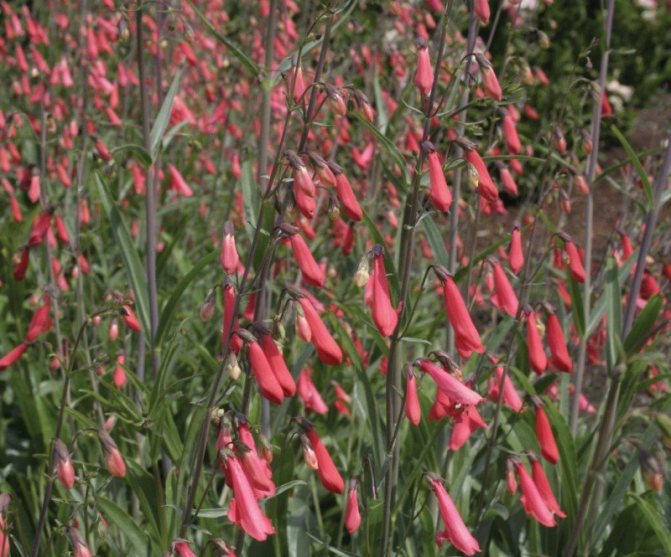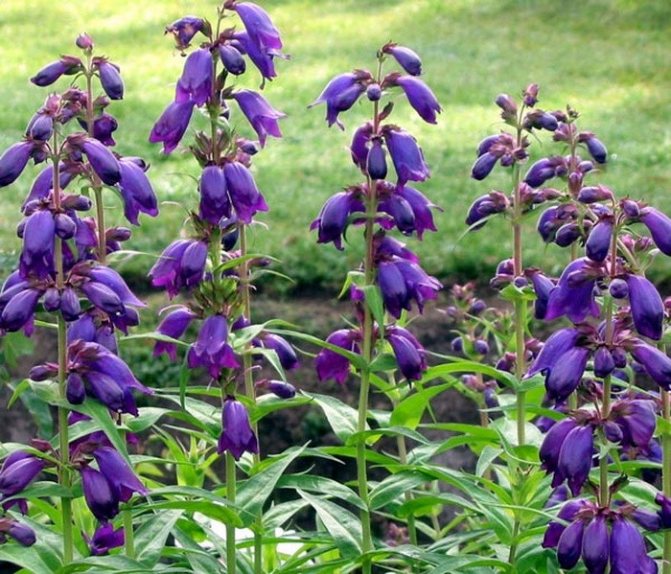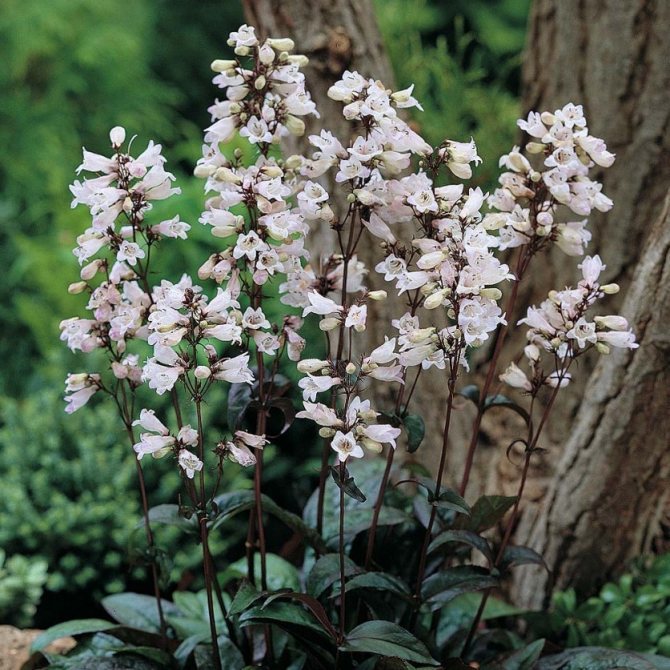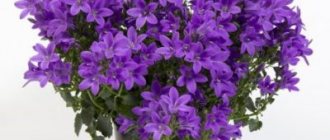Penstemon is a flower imported from North America, common in Europe and Asia. Tall. It is easy to grow it at home even in Siberia, as there are positive reviews, photos and videos. At home with him a little trouble. Can be prepared for seedlings so that the penstemone can be grown from seed next year.
Types and varieties of penstemon
Penstemon is a perennial, herbaceous plant. Stems are weakly branched. Penstemon foliage is large, bright green, shiny. Flowers of various sizes and colors, collected in dense paniculate inflorescences, rarely single, pink, white, red, purple, blue.
Penstemon whitish
Perennial 30 cm long. The leaves are oval, often roughly textured like sandpaper. The flowers are pale pink, white, lavender. Blooms in May.
Penstemon alpine
A perennial growing in the form of a thick pillow. The flowers are yellow-lilac with a snow-white throat, collected in an umbrella-shaped inflorescence. Alpine penstemon bloom occurs in the middle of summer.
Penstemon the bearded
The homeland of the bearded pestemon is North America.
Herbaceous plant 90 cm long. Stems are branched, straight, strong. The foliage is dense, lanceolate. The flowers of bearded penstemon are 3 cm in diameter, scarlet-red or pink.
Blooms 45 days in June. There are forms with pink and white flowers. The plant is winter hardy.
Penstemon Cobo
North America is considered the homeland, where the plant grows on dry prairies, slopes and pastures.
A short-lived perennial plant. Root foliage is sometimes absent. Stem leaves are smooth, thick, serrated. The stems of the Kobo penstemon are erect. The flowers are large, pale purple, pinkish or white.
The corolla is smooth on the inside, pubescent on the outside. This type of penstemon blooms in May. It is well pollinated by bees. Feels great on limestone soils, loamy or sandy. From seeds, the plant blooms for 2 years. Does not tolerate waterlogging.
Penstemon Davidson
Homeland are the mountains of Canada and the United States.
Perennial up to 10 cm in height. The foliage is appressed, slightly pubescent or smooth. The flowers are reddish-violet, collected in few-flowered inflorescences.
For successful cultivation, you need a dry place with sandy, drained soil. In winter, Davidson's penstemon needs shelter from the dampness. It winters well only under good snow cover.
Foxglove penstemon
The states of North America are considered homeland.
It is one of the most frost-resistant penstemons. Perennial up to 1.2 m tall. Basal foliage is evergreen. The flowers are tubular, pink on the outside and white on the inside. Blooms in summer.
Penstemon foxglove "Husker Red"
- with bronze foliage and a mass of snow-white or pink airy flowers.
Penstemon foxglove "Evelyn"
- bright pink flowers.
Loves a sunny place, tolerates light partial shade. The soil needs fertile, acidic. Lighter than all other types of penstemone tolerates dampness.
Penstemon bush
Grows in the mountains of North America.
Semi-shrub plant 40 cm long. In the spring, flowers appear in a violet-blue pale purple color. Penstemon bush frost-resistant.
Penstemon Hulla
Grows on rocky mountain slopes in Colorado, at an altitude of 4700 m.
Perennial plant up to 20 cm in height. The foliage is thick, bluish green. Inflorescences are racemose of 15 flowers. The flowers are blue-violet, bell-shaped. Flowering occurs in summer. Grown in rock gardens. Penstemon Hull needs poor soil, covered with gravel.
Penstemon haired
Homeland North America.
Perennial 80 cm tall. Leaves are green lanceolate. Blooms penstemon harsh-haired funnel-shaped pink, pale purple flowers. Needs a sunny location, tolerates light partial shade.
Penstemon graceful
Grows in North America.
Perennial plant 20 cm long. Stems are dark purple. The flowers are pale lilac or white. The corolla is whitish. Graceful penstemon blooms in summer. Loves sunny places with sandy gravel soil.
Penstemon pine-leaved
Evergreen light green dwarf shrub with thin little branching stems. The foliage is opposite, narrow, densely located on the stem like pine needles.
Pinestemon pine-leaved flowers in racemose inflorescences, red. Abundant flowering. There are cultural forms with yellow flowers. Blooms in August.
Penstemon pine-leaved reproduces by dividing curtains or cuttings. The cuttings must be rooted in a greenhouse. Plant best in dry, fertile soil. Penstemon pine-leaved prefers sunny places or partial shade. If you manage to adapt to this culture, then beautiful decorative leafy carpets can be formed from this plant.
Variety characteristics
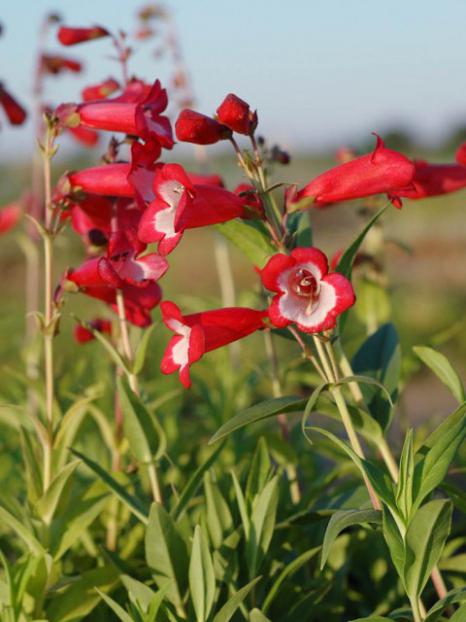
Plants, whether they are erect or creeping, require the same conditions for germination, flowering and care. Penstemons bloom during the period when the first early spring blooming plants fade.
Penstemon, cultivation from seeds of which is best started at the end of winter, will give large inflorescences of bells, which will bloom precisely during the transitional summer period. At a time when spring is gaining momentum every day, and matinees are gradually disappearing. This is exactly the time interval when spring flowers blooming in the middle of summer begin to gain strength and form buds.
The penstemon flower is a plant that can be said to be universal, in the sense that wherever you plant it, it will look great everywhere. Therefore, these flowers are used for planting on alpine slides, rabatki, flower beds. It is desirable to plant in groups of other plants. Firstly, it adjoins almost all colors, and secondly, it beautifully emphasizes the decorativeness and shades of different colors.
Perennial penstemon can also be planted in pots. It is better to hang them from the upper supports, because when the plant blooms, its numerous clusters of bells cause the stems to sink to the ground under the weight of the flowers. Looks very impressive.
Penstemon partners
It goes well with plants of yellow and orange tones - dimorphoteka, calendula, coreopsis, rudbeckia; with white flowers - yarrow.
There are two main methods of seed growing: by seedling or directly into the ground. Each method requires the selection of quality seeds. Some varieties of seeds need to be planted before winter, while more capricious ones require a lot of sunlight. It is enough to sow some varieties in the period from February to March; you don't even need to cover it with a layer of earth on top. But often those varieties that are grown in seedlings are sown on the plots.
Reproduction methods
In addition to seed propagation, used to breed penstemone in your area or to grow a new variety, you can propagate the culture by dividing the bush, planting a stalk, or using layering.
Reference! The bearded penstemon has one root, so the method of dividing the bush does not suit him.
Breeding options:
- A split bush is planted in spring or autumn. To do this, the plant is dug out, removing the excess soil, divided into parts and planted in a permanent place at a distance of 1 m between the divisions. When planting in a hole, you can add humus, a little sand. After it is good to shed the earth.
- Layers. In the spring, when shoots appear, one of them is bent down and covered with earth. Roots quickly appear at the place of fixation, and the shoot can be divided into parts for transplantation. This method is rarely used, since rooting is difficult for the plant.
- Cuttings are cut from a branch without flowers, cutting at an angle, and immediately planted in the soil, keeping a distance of 30-40 cm between the seedlings. Cover the top with a transparent plastic (cut off) bottle or jar - this is how you get a mini-greenhouse. Plantings should be protected from bright sun.
Information! In one place, the perennial penstemon grows for 3-4 years, then you need to transplant it to a new place so that it continues to bloom.
Sowing rules for penstemon
Some tricks will allow penstemon to bloom profusely.
Use cold stratification before growing penstemon. Then the germination of the planting material will be good.
Sow seeds into moist soil. Seeds will not germinate without moisture.
When penstemon seeds appeared in the ground, they should be covered with sand with a layer of no more than 3 mm, covered with glass or foil. Pour boiling water over the sand beforehand - this will disinfect it.
At this stage, provide the seeds with a temperature of 18-24 degrees. Then, after one or two weeks, you can wait for the first shoots.
As soon as you notice the first shoots, lower the temperature slightly to 15 degrees. Then grow in peat pots. This is an effective method of ensuring abundant flowering in the future.
When two leaves are formed on the sprouts, start diving. By the end of May, it should get stronger, and the earth should warm up, so you can plant the plant in the ground. Maintain a distance of 30 cm between seedlings.
With this growing method flower penstemon
from July to September. If you start work 1 month earlier, then flowering will come later, its intensity will be significantly lower.
Penstemon is a large genus of flowering plants from North America and East Asia. Only one single species is represented on the territory of Russia, in the Far East - P. Frutescens. Previously, botanists assigned it to the Norichnikov family, but thanks to the latest genetic research, it was placed in a new, more extensive group of the Plantaginaceae family.
One of the Asiatic species, previously placed in the genus Penstemon, has now been isolated as a separate genus Penneliant. This makes the penstemone flower a mostly Nearctic genus with several neotropical species. Although the plant is widespread throughout North America and inhabits areas ranging from open desert to humid forests and alpine zones, as a rule, they are usually not the same within their distribution range.
Native Americans use penstemone as a medicinal plant for humans and animals. John Mitchell published the first scientific description of a flower in 1748, although he only named it Penstemon, at this stage in the development of science we can already define it as Penstemon Levigatus. Subsequently, Carl Linnaeus included it in his list of 1753 publications as chelone pentstemon, changing the spelling to more closely match the name, which mentions the unusual fifth stamen (translated from Greek "penta-" - five). After some time, Mitchell's work was published with the preservation of the author's spelling and, ultimately, the form of spelling was adopted as the official one.
Penstemon seeds in Europe first began to be sold only in the 19th century, over time, many flower hybrids were developed in this region.
Seating
In order for you to enjoy the beautiful blooming view of the penstemon, it will definitely need to be planted in the future, and moreover to do it correctly, otherwise it may affect its flowering. It is possible to carry out a pick only when two full-fledged leaves appear on the seedlings. It will be just great if you plant flowers in peat pots. Perennial Penstemon is a plant that does not really like when it is often transplanted.
In addition, peat pots create the preconditions for flowers to bloom earlier, longer and more abundantly. Penstemon is planted in open land at the very end of May, or at the beginning of June. Most importantly, remember that the larger your penstemon becomes, the more difficult it will be for it to root in a permanent place. Peat pots again help solve this problem.
The optimal distance between plants is from 30 to 40 cm.A little advice: do not plant the sprout too early, it needs warmth, and the cool temperature on the May bottoms and nights of millet will stop its growth, so it will take a long time for the flowers to grow again ... In general, it turns out that in order for the plants to bloom abundantly and on time, they need to be planted in a permanent place on time.
Description of penstemon and a photo of the flower in various angles
Penstemon is a herbaceous perennial that forms a spear shape with leaves and thorns on tubular flowers. The flowers of the plant are usually pink, red, white, purple and occasionally yellow. They are collected at the top in dense paniculate inflorescences. The description of penstemon may differ depending on the cultivar and the various distinguishing characteristics of the hybrids. But in the photo, the penstemon flower can be identified with a fairly high degree of probability:
The nickname "bearded tongue" refers to pollen without stamens, which protrude from under the flower, resembling bearded iris in this regard. Botanists very often refer to the appearance of this beard when distinguishing the Penstemon species.
The fruit is a polyspermous box with two valves. The seeds are usually brown in color, slightly angular and small in size. One of the main advantages of penstemon flowers is that their seeds remain viable for two years, and after sowing they ascend in two weeks.
As we said earlier, penstemon flowers are mostly herbaceous perennials, while the rest are shrubs and dwarf shrubs. Their height can vary from 10 centimeters to 3 meters.
The flower stems branch weakly, but they are very strong.
The leaves are most often spear or oval-shaped, and can also be red-purple in color (in some species). Look at the photo of the penstemon flower in various angles and uses of this plant:
Pest diseases and growing problems
One of the most common problems is the drying of the tops of the shoots. In this case, the plant is subjected to radical pruning, almost at the root. If this is not done, penstemon will die. After timely pruning, the bush quickly recovers and starts up new shoots.
When the soil is waterlogged, gray rot can develop on the roots of penstemon. The sluggish stems of the plant speak of decay of the roots. In this case, you need to loosen the soil and water the bush with a fungicide.
Pests bypass this plant, so you won't have to fight them.
Planting penstemon at home and caring for the plant
Planting penstemon at home is very simple, and even an inexperienced amateur gardener can handle this process. Penstemon is grown from seed - sow them directly into your flower garden in summer or autumn, when the probability of frost is low and the soil has already warmed up.If you are still afraid to plant it in open ground right away, then, in principle, you can start by growing it indoors. You can stratify the seeds in the refrigerator for three months and then plant them in pots. Place the seeds on top of loose soil and lightly dampen it. They germinate better when aged, that is, if you want to get the most effective result, we recommend planting seeds that have been aged for about two years.
Penstemone can also be propagated using rhizomes. For planting, you will need to dig up and divide the plant (this procedure is recommended to be carried out once every 3-5 years). You just need to dig up mature rhizomes and replant them.
They prefer full sun, but they can also easily survive in partial shade. When caring for the penstemon plant at home, keep in mind that the flower needs well-drained soil, since not all species are able to grow and survive normally in high humidity conditions. They thrive well in loose, gravelly soil, but also thrive on ridges or hillsides and mountains. During the growing season, fertilizing is not required - additional feeding will only lead to vigorous growth of foliage, but not flowers.
It is required to actively water the flower only during the dry season, but not deep into the roots - approximately at the level of 33-35 centimeters. Be sure to let the soil dry out between waterings. You can add a general fertilizer at the beginning of planting and add it every 1-1.5 months for one season. Just before flowering, look for fertilizers with high phosphorus levels.
When the flower is in full bloom, you can trim the thorns - this is necessary so that the plant also blooms next year. To preserve the root system, add a layer of mulch to the soil for the winter.
Penstemon does not get along well with other flowers, so experienced gardeners recommend planting them further away and giving more space in the garden.
Flower care
Penstemon must be placed on well lit plots. The plant is light-requiring. The flower prefers light, well-drained soil and ample watering.
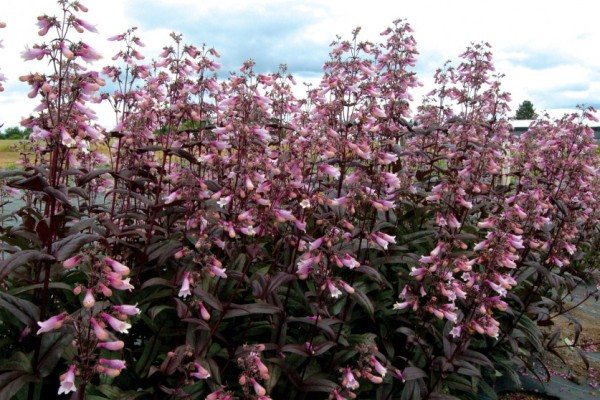

Penstemon prefers open, well-lit areas
Plant does not tolerate stagnant moisture... This leads to root rot.
It is necessary to periodically loosen the soil and fertilize three times per season. Penstemon can be fertilized with both organic and complex mineral fertilizers. This will allow for a more lush bloom.
The flower should not be placed in wind-blown areas. Penstemon doesn't like the wind.
For the winter plants undercut and coverto protect against severe frost. You can use leaves or spruce branches.
Perennial Penstemon is not easy to care for!
The perennial penstemon is the most popular type of home flower, reaching one meter in height, with luscious green leaves and bright, colorful flowers. The plant is ideal for landscaping, as its colorful flowers and foliage will adorn any space. Like all decorative varieties, perennial penstemon is not so easy to care for. We advise you to sow flowers in March - then he will receive a sufficient amount of light, and the soil will have time to warm up. If you want to grow faster, you can refrigerate the seeds for a couple of days before sowing.
It is worth planting in open ground only after mid-May, when the danger of frost has completely passed. Penstemones are very sensitive to changes in temperature, humidity and wind.
They feel best in a sunny place, but the soil must be moist, but not flooded. If the top of the flower begins to dry out, then it is best to cut off the entire bush at once and wait for new shoots to appear. Otherwise, you will achieve the fact that the whole bush will die at once.
Application in landscape design
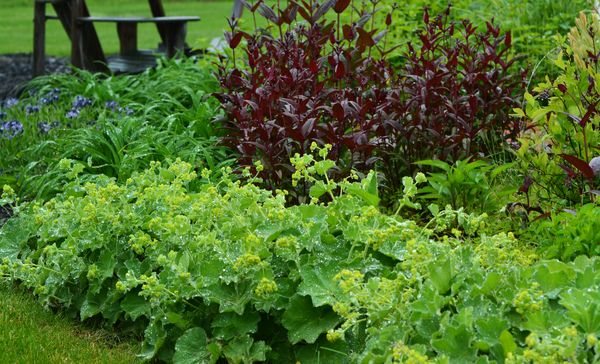

Application in landscape design
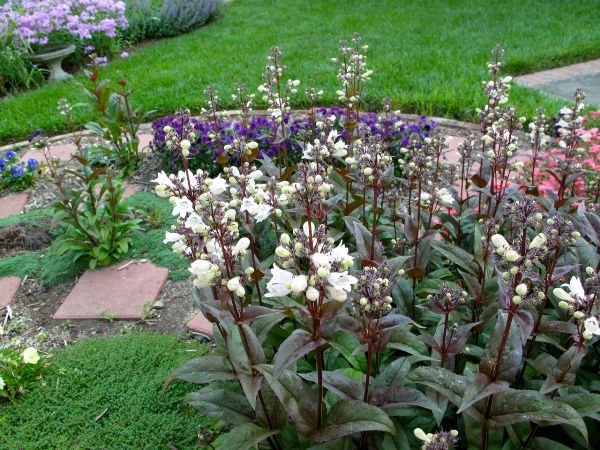

Application in landscape design
Penstemon is still a fairly rare guest in garden plots. But thanks to high decorativeness the plant has already found its admirers and is gaining popularity among flower growers and designers.
Looks great on verandas, grows well in outdoor flowerpots, is a bright decoration of alpine slides. Penstemon is also suitable for cutting. Although the flower does not last long, the bouquets look very beautiful.
Penstemon is a novelty in garden plots. But thanks to its unpretentiousness and beauty, the plant gains more and more friends and fans every season. After all, very little effort allows you to get amazing beauty at your summer cottage.
Penstemon heartweg and sensation, bearded and cobo
Penstemon heartweg is a fluffy, evergreen plant with simple, narrow, fleshy green leaves. Inflorescences up to 4 centimeters long, bell-shaped, can have a bright red, purple or dark red color. There are white markings on the wide throat. Growth and flowering time is summer and early autumn. Penstemon heartweg can reach 30-70 centimeters in height.
Penstemon sensation is the scientific name for the Penstemon hybrid. Grown as an annual plant. Flowers of various shapes and colors are collected at the top in a paniculate form. Gardeners and landscape designers advise planting them in a group with other flowers - this way, your site will look even more spectacular.
The bearded penstemon is also known by the popular names "penstemon golden beard", "penstemon bearded lip" and "scarlet bugler". This genus of flowering plants comes from the western United States.
The bush has six clustered, tubular scarlet flowers with yellow hairs on the lower lip, making the flowers very attractive to hummingbirds. It is widely grown in irrigated soils and simple gardens. In late summer, the blooming of the bearded penstemon coincides with the southern migration of hummingbirds, and the latter use the scarlet buglers as a fueling station for the long flight south.
Penstemon kobo has spectacular flowers of a purple or pink-purple hue, five centimeters long. Thick stems grow from a woody rhizome and bear thick, paired leaves that shrink as they approach the stem. Often during flowering, the lower leaves dry out.
This plant is very attractive to butterflies.
Penstemon foxglove and hybrid
Penstemon foxglove of the plantain family. White petals bloom in the summer. Homeland - Eastern Canada and the southeastern United States.
The plant has opposite, simple leaves on slender purple stems. The stamens have small tufts of "hair". The foliage has a more attractive, dark green hue. The flower grows in any moist soil provided it is stored in full sun.
Penstemon hybrid is a perennial herb of the Scorch family. It is often grown as an annual plant. This name refers to all hybrid varieties and garden forms.
Penstemon is an ornamental culture native to North America. But today this plant began to be actively cultivated in the conditions of the Russian climate. Penstemon fully fulfills its decorative function. It grows in the form of a bush with peduncles.
At their ends, there are bright inflorescences collected in a brush. Today, many gardeners equip a flower bed with penstemon. But for this, you first need to familiarize yourself with the main features of growing and caring for this crop.
General characteristics and description
This plant is still quite a rare guest in our area, but the aroma and natural beauty of penstemon is quickly gaining popularity among garden flower lovers. The homeland is considered to be North and Central America, where there are about 250 species.
One of them grows in East Asia and also, in the only species so far, we can observe in Russia in the Far East - Penstemon frutescens Lamb.
The name is really a bit outlandish, but the translation explains why this particular name was given to the plant: translated from Greek "pente" - five and "stemon" - stamen, that is, there are 5 stamens in each flower.
Penstemon is a herbaceous and rhizome plant, perennial, belongs to the Norichnikov family. Height reaches 1 - 1.2 m. One to several stems grow straight, slightly branched, have a strong structure.
The leaves are arranged opposite, dark green, lanceolate in shape, entire, shiny and large without cuttings. Flowers are found in very different colors: white - pink, purple, lilac, blue. They are collected in panicles - inflorescences. There are quite a few of them on the stem.
They are located mainly in the upper part of the stem. Flower sizes can be larger and smaller. Sometimes the inflorescence is in one copy. Corollas have a bell-shaped and tubular shape 2 - 3 cm long. The petals are double-lipped, branch out to the sides, forming a bowl.


The penstemon fruit is presented in the form of a bivalve seed capsule, which has up to 10,000 small, brown seeds. They are suitable for planting for two years. Germinate 14 days after sowing.
Description and varieties
Penstemon has about 250 species. But not all of them can be grown in the Russian climate. Will only focus on the most popular ones.
Bearded
It is a herbaceous perennial plant, the height of which reaches 70-90 cm. It has straight and strong stems, which are prone to slight branching. On it you can find leaves, which are ovoid and opposite in shape. In the month of June, bloom can be observed. The flowers are tubular, and their size reaches 2.5 cm. Flowering lasts for 1-1.5 months. The petals can be colored pink or red. The most popular are the following varieties:
- Coccineus
... It is a serrated flower that has a red tint. The plant grows to a height of 60-120 cm.How the red ball is grown from daisy seeds, you can understand by going to - Dark towers
... This is a herbaceous culture, the height of which reaches 10-90 cm. It is decorated with lilac-green leaves and white-pink flowers. how the care and cultivation of Pink Periwinkle takes place, and how such a flower looks like, you can understand by looking at this - Rondo
... The height of this plant reaches 40 cm. The bush is covered with red and blue bells. It will also be interesting to know about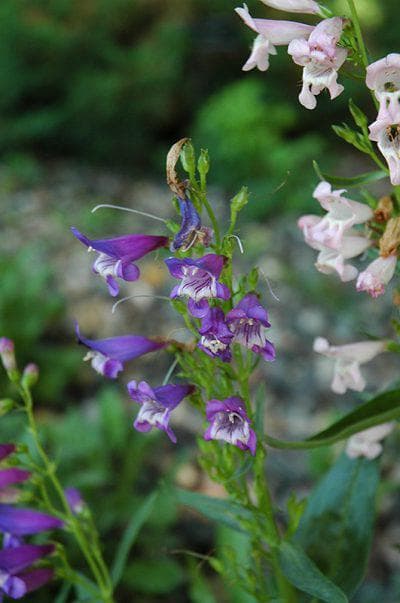

- Rubycunda
... Shoots grow to a mark of 50 cm. You can see scarlet flowers with a white throat in June. - Iron maiden
... This plant has smooth stems, at the ends of which there are red flowers and a narrow-tubular shape. But how the red castor bean is grown, you can find out by reading this - Cobo
... This variety loves to grow on dry soils, slopes and pastures. And although the plant is perennial, it does not live long. Leaves are smooth and stem-like. Inflorescences are large in size, presented in pale lilac and pink shades. But how it happens, and how it happens, this information will help to understand. - Love Formula
... On the inside, this plant has a smooth corolla. Flowering can be seen in May. The plant is perfectly pollinated by bees. Grows on loamy, sandy and limestone soils. Does not like too waterlogged soil.Love Formula
Foxglove
This plant is known to all for its resistance to frost. The height of the bush can reach 60-120 cm. The rosette of basal leaves will remain unchanged throughout the year. The long, branched shoots contain cream to pink flowers and are tubular in shape.You can observe flowering in June. The following varieties should be attributed to the amount of popular ones:
Brilliant
This perennial penstemon can grow up to 25 cm. At the base of the stem, a bunch of long leaves are concentrated, which have a lanceolate shape and a rounded edge. The culture is decorated with gray-green flowers.
Brilliant
The plant is frost-resistant and blooms in May-June. It is lush and abundant. The petals are quite lush, and the size of the buds is 2-2.5 cm.
Reproduction
So, we already know that penstemon, the cultivation of which begins in winter, blooms profusely in the first year. Flowers can be planted with cuttings, which are cut when new young shoots appear, around the middle of summer.
You can also breed the penstemon flower by dividing the bush. Growing from seeds is not, as we can see, relevant when you decide to get acquainted with a beautiful flower for the first time. By the way, the division of the bush is carried out in a strictly defined period. This is early spring - a time when the plant has not yet entered the active growth phase.
Creeping varieties are propagated by fixing part of the stem. At one point, it is slightly pressed into the ground, sprinkling it on top. After the scion gives roots, it can be detached from the main bush.
How and when to plant
Reproduction of penstemon occurs in two ways - seed and vegetative. But most often gardeners use the first option. The plant is unpretentious to care for and perfectly tolerates any manipulation. You need to grow penstemon from seeds in February. For this, the seedling method is used. It is necessary to prepare the box, fill it with a sandy-peat substrate. Sow the seeds and trample them with the earth. Place the container in a well-lit place. Cover it from above with glass or foil. For better germination, the planting material can be sprinkled with sand. By the way, this breeding method of Penstemon is very similar to.
The soil will have to be sprayed regularly. It should always be hydrated. It will be possible to observe seedlings in 10-14 days. It is necessary to grow seedlings at a temperature of 18-24 degrees. From this moment it is necessary to remove the film and glass for 2-3 hours a day. Thus, the seedlings will be hardened.
When 2 leaves are formed on the seedlings, then it is worth performing a pick. For this, separate peat pots have to be prepared. It is with them that the seedlings are sent to the open ground at the end of May.
The video shows how and when to sow:
If you live in the southern regions, then the planting material can be immediately sent directly to the open ground. Such activities must be completed in November. When to expect the first shoots, it will be possible in early spring. But flowering will occur much earlier than during spring planting.
Growing
Penstemon, whose seed cultivation began in February, usually manages to reach the necessary maturity for flowering at the right time. Recall that this is somewhere in the beginning or mid-July.
The seeds are laid out on moist soil, they are laid out, without embedding in the soil. They need sunlight to germinate. From above, future flowers are sprinkled with wet sand, covered with film or glass and left warm. In this state, the sprouts will appear within 10 days.
To increase germination, seed stratification can also be carried out. But even without such an operation, it is quite easy to germinate the planting material of such a plant as the unusual penstemon flower. It is advisable to grow seeds at a temperature of about 24 ° C, and when the first shoots appear, it is better to reduce it by ten degrees. The seedlings feel more comfortable this way.
How to grow
And although the culture is unpretentious in terms of care, it will not work just to plant it and forget about it. It is imperative to carry out mulching. This will prevent moisture evaporation. In addition, fertilizers are to be applied 2 times a month. It is best to use mineral dressings for this. By loosening and removing wilted flowers, penstemon will flower longer and have a decorative look.
The plant needs to be pruned regularly. As soon as flowering ends, remove wilted branches and dry foliage. In the fall, you need to move on to radical pruning. Almost the entire above-ground part is removed. Sometimes gardeners leave a rosette of root leaves. Every 3-5 years, even with proper care, the shoots will stretch out and become bare, and the flowers will become small. So it is necessary to rejuvenate the bushes by replacing them with new ones.
And although penstemon is a culture resistant to various ailments, with a strong waterlogging of the earth, fungal ailments can strike it. Often the culture is affected by a disease characterized by drying of the top.
Penstemon is a unique decorative culture, which today has begun to actively decorate flower beds and flower beds. Such popularity is due to the fact that the plant is unpretentious in care, withstands frost and gives a lush and bright flowering. And thanks to a wide selection of varieties, each gardener can create a unique flower arrangement.
Penstemon is a flower native to North America, but recently the flower culture has quite mastered the Euro-Asian continent. The plant is very decorative: a tall bush with peduncles, at the end of which there are bright flowers, collected in a brush. All amateur gardeners who have seen amazingly beautiful flowers would like to start cultivating a plant in their garden. They are interested in the question: how to grow penstemon?
Penstemon: planting and care
The most popular is perennial penstemon. Growing a penstemone from seed requires a lot of work and patience.
In order to increase germination, it is recommended to hold the seeds in a cold place for a month before planting. Sowing of penstemon seeds is carried out in late February - early March. Seeds are planted almost on the surface of the soil so that the developing plant receives more sunlight. On top of the sown material, sprinkle a little with sand, moisten and cover with cellophane to create a greenhouse. The room in which the plantings are kept should be warm (about + 22 ... + 25 degrees) and light, then the first shoots hatch by the end of the second week.
With the appearance of sprouts, the film can be removed and after a few days the seedlings can be transplanted into peat pots. Now the air temperature should be lower, preferably + 14 ... + 17 degrees. If these measures are followed, an earlier flowering of the plant can be expected. After the appearance of two true leaves, the plantings dive. They are planted in open ground depending on the climatic zone: from mid-May to late May. At the same time, a distance between the bushes of about 35 cm should be maintained. Given the special sensitivity of penstemons to winds and weather changes, it is better for the plant to choose a well-lit place, protected from all sides. The soil should be neutral, rich in humus. For better growth, coarse sand or gravel can be added to the ground, since the plant does not tolerate stagnant moisture in the roots.
Maintenance includes regular watering, weeding and protecting the plant from excess moisture evaporation on hot days. Approximately twice a month, it is necessary to feed penstemon with complex fertilizers. To maintain a decorative look, dried peduncles should be periodically removed. A phenomenon is often observed when the top of the plant dries up. To prevent the death of the bush, you should cut off the diseased part of the stem or even prune the entire plant so that healthy shoots appear. But the fall of flowers in rainy and windy weather is normal. In place of the fallen, new flowers are constantly growing.
Penstemon is propagated by cuttings. In August, it is cuttings, and the rooted cuttings are stored at a temperature of + 3 ... + 7 degrees. In the spring, the plant is planted.Penstemon from cuttings blooms almost a month earlier than flowers grown from seeds.
Preparing penstemons for wintering
Many types of penstemons do not tolerate temperatures below -10 degrees, so it is recommended to provide shelter for flower plantings for the winter. For this, the ground part of the plant is cut off and a rather thick layer of spruce branches or foliage is created. If the wintering was painless for the plant, then on the rest of the bush, green foliage should remain until spring.
Using penstemons
The plant blooms from July to autumn frosts, decorating the place of growth with its long inflorescences. You can plant penstemon in rows in, planting with low flowers (marigolds, ageratum, etc.), or in a mixborder in groups. Cut penstemons look great both in mono bouquets and in combination with other flowers.
We also recommend
- How to make a wasp trap out of a plastic bottle?
- How to get rid of wasps in the garden Do-it-yourself adhesive strips
- The best options for removing fleas from the apartment Insecticides for fleas in the apartment
- Signs of bedbugs
- Wood finishing about types of wood finishing Materials used for finishing wood products
- Drops for kittens from fleas: types, application, dosage Is it possible to wash newborn kittens from fleas
Wintering features
Penstemon is resistant to frost, and in regions with warm winters, except for autumn pruning, it does not require any measures. In regions with harsh winters and severe frosts, shelter is required. In late autumn, the entire aerial part of the plant is cut off. The rhizome is covered with a layer of dry foliage or straw, and then spruce branches.
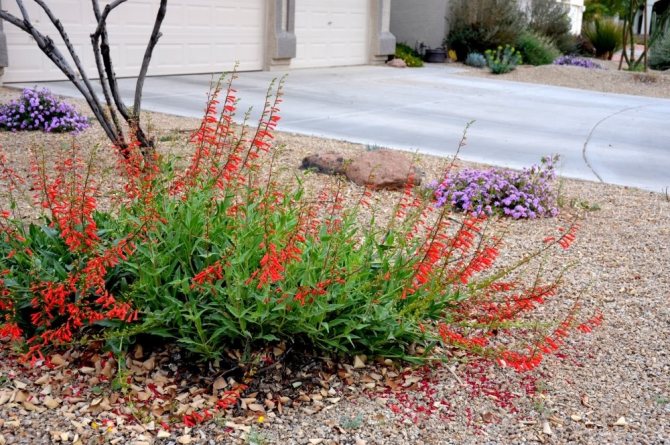

Penstemon tolerates light frosts well.
In winter, the plantings are additionally covered with snow. As soon as the spring warms, the snow from the penstemon must be removed so that the roots do not become waterlogged. It is more dangerous for a plant not to freeze, but to get wet with an excess of melt water.
Penstemones for annual culture
Many types of penstemons (herbaceous perennials, shrubs and shrubs) are not winter-hardy in our latitudes. But some perennial species are able to bloom in the year of sowing, so they can be grown here as annuals. Among them is a collective species - hybrid penstemon (Penstemon x hybridus), which combines varieties of complex hybrid origin. All hybrid penstemones are usually semi-evergreen, with narrow, rarely ovoid leaves.
One of the most popular varieties -
- Andenken an Friedrich Hahn (syn. Garnet) - a hybrid of penstemon campanulata (Penstemon campanulata), obtained with the participation of many species, 0.5-0.9 m tall, perennial or semi-evergreen shrub with thin stems, green spear-shaped leaves and flowers up to 3 cm long, garnet-red (the word garnet translates as "pomegranate"), with a white neck covered with red strokes. Winter-hardy up to -17оС. Tolerates poor and dry, alkaline soils, loves the sun.
|
|
However, not all hybrid penstemones reproduce by seeds; most retain valuable traits of the variety only during vegetative propagation.
- Papal purple - new, one of the lowest hybrid penstemons, 40 cm high. Semi-evergreen. It has narrow foliage and abundant purple flowers, with darker markings in the white neck, which bloom from early summer until the first frost. Winter-hardy up to -17оС. Good for curbs. Propagated by cuttings, seeds are not reproduced.
Penstemon hartwegii is one of the species grown in annual crops. The species is named after the German botanist Karl Theodor Hartweg (1812-1871), a researcher of the flora of North and South America.
In warm southern regions, this penstemon can winter under mulch (winter-hardy up to -21 ° C). The plant is 30-70 cm tall, with straight stems branching from the base.The leaves are narrow, fleshy. The flowers are large, up to 4 cm long, with a long bubble-shaped tube and a wide two-lipped limb, two-colored - red, dark red or purple, with a white tube inside.
The seeds of this plant are the most common in our sale, for example, there is a variety mixture "Chanson" of different colors (pink, red, purple). Plants are quite winter-hardy, you can try to keep them under cover even in the middle lane.
Also not rare seeds of penstemon "Spirit", without specifying the species. Similar to Hartweg's penstemon, it has large ruby-colored flowers with a white neck. Grown as an annual.
|
Watering penstemon
The flower needs regular watering, this is especially important in the dry season. The soil should dry out between waterings. At the same time, it is necessary to ensure good drainage of the soil, stagnant water can simply destroy the plant. To reduce the frequency of watering, mulching is used, which prevents the rapid evaporation of moisture. In addition, it is advisable to periodically loosen and weed the soil around the plant.


Landing
Penstemon is quite unpretentious, but to achieve the most decorative look, it is best to plant it in areas with bright sunlight. In partial shade and shade, the flower is able to develop, but due to a lack of light, the color of the inflorescences can be several tones paler than that of the same variety grown in the sun.
The main condition for successful maintenance in the garden is the correct choice of soil for planting, which should be light and nutritious. It is necessary to provide good drainage, eliminate stagnation of water in the ground and protect the plant from drafts.
Organic fertilizers such as humus or compost are optimal for fertilizing. It is better to introduce them in the spring before the plant blooms.
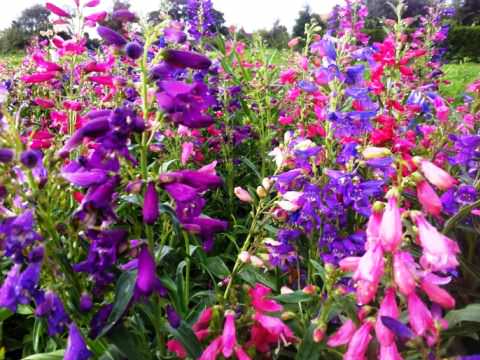

Despite being undemanding to planting and leaving, penstemon still needs attention. To prevent the soil from drying out, the surface around the plant must be mulched. Prolonged drought can destroy the plant. To provide oxygen access to the rhizome, it is necessary to loosen the ground, and to preserve decorativeness and to achieve the longest flowering, it is recommended to remove faded inflorescences and dry stems.
To form neat bushes, the perennial is shortened. Do not neglect this procedure - a beautiful perennial grows quickly enough under favorable conditions, and the removal of excess shoots contributes to abundant flowering.
In the fall, before the onset of frost, the bushes are completely cut off and covered with spruce branches. This will help protect the flower from adverse conditions and preserve the rhizome as much as possible, which may suffer when the soil freezes.
Subject to the simplest rules of planting and leaving, penstemon can grow in one place for up to 4 years without losing its external characteristics. Despite the fact that this plant is perennial, over time, the bushes age and become unsightly. In this case, it is worth thinking about updating, annually sowing seedlings or carrying out cuttings of adult bushes.
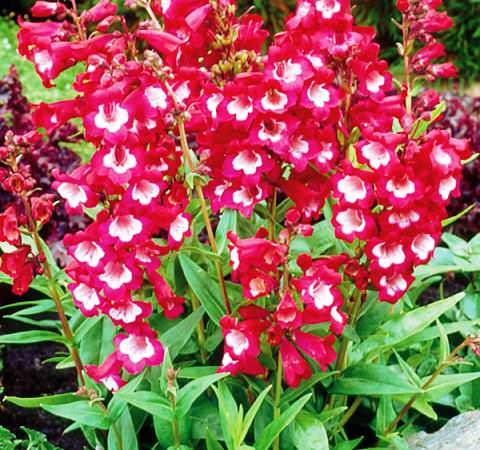

Growing seedlings
In order to grow penstemone, you will have to make an effort and be patient.


Timing
The most suitable period for sowing seeds for seedlings is the end of February - beginning of March.
Soil preparation
The soil for sowing seeds should be light, nutritious and well-drained. Sow the seed into slightly damp soil.
How to plant
The containers are filled with soil and future seedlings are sown in them. Sprinkle on top with a thin layer of disinfected sand. To do this, just spill it with boiling water.
It is not worth deeply deepening the seeds, this will reduce their germination.
From above, the containers are covered with polyethylene or glass to create a greenhouse. Place in a warm, bright place.
Watering
It is important that the soil does not dry out, otherwise the seeds will sprout poorly or not at the same time.From time to time, the seedlings are opened, aired and sprayed with a spray bottle. The germination process takes 1 to 3 weeks, depending on the penstemona variety.


Picking
After 10-15 days, the shoots have already formed 2-3 true leaves. This means that they need to be dived into separate containers with peat.
Transfer
Already grown plants are transplanted into open ground. This process takes place at the end of May. The site must be sunny and free of drafts.
Important! The sooner the penstemone is planted in open ground, the later it will begin to bloom.
Compost, peat or sand are added to the dug holes, and fine gravel is also used. When planting seedlings, a distance between plants of 30-35 cm should be observed.
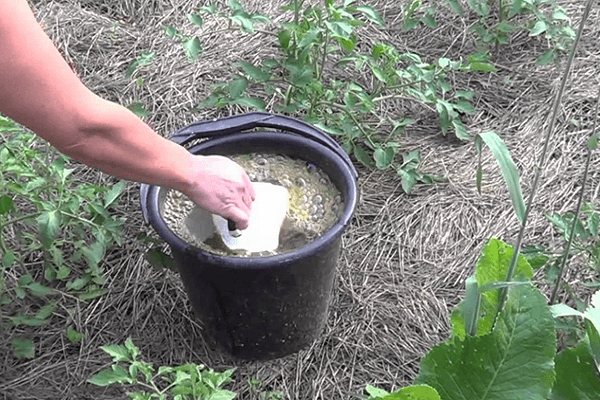

Mulching
The soil around the flowers can be mulched to reduce the amount of watering. For this, dry peat or compost is used.
Top dressing
As a top dressing, organic fertilizers are applied under the bush. This is done 3 times per season. And before the plant begins to bloom, it is fed with complex mineral fertilizers that contain phosphorus. Such feeding has a positive effect on flowering, enhancing it and making the bush more decorative.
Bloom
The flowering period for each variety comes at different times, but most often it is June. This process continues until the end of summer, and in some varieties, up to the first frost. The beginning of flowering is influenced not only by the variety, but also by the time of planting, the soil in which the flower grows, and caring for it. After the plant has faded, seeds begin to form, which are used for reproduction.
See also
Preparing lavender for wintering in the Moscow region and how best to cover the plantRead


Pruning
During the development of the flower, pruning should be carried out periodically. Withered inflorescences and foliage are cut off. They also thin out overgrown bushes. This will increase the decorative effect of the plant and extend the flowering period.
Preparing for winter
Winter frosts below -10 degrees for most penstemon varieties can be adversely affected. In order to preserve the plants, after the end of flowering, their stems are cut to the root and insulated with dry foliage or spruce branches.
Diseases and pests
Penstemones are resistant to diseases, but if the plant is systematically flooded or water stagnates under the bushes for a long time, fungal diseases, in particular gray rot, can develop. In order to cure the plant, the soil under the bush is loosened and watered with fungicides.


Drying of the top of the plant sometimes occurs. In order to get rid of this problem, you need to completely cut the bush. Without doing this, you can lose the plant. When pruned, the penstemon will quickly recover and sprout new shoots.
For insects, this flower is not of interest, so they rarely attack it.
Penstemon transplant
So that the plant does not lose its decorative properties, it should be transplanted every five years. Usually, the transplant is performed in the spring, by bush division. For this purpose, an adult plant is taken, carefully dug up and divided into parts, trying not to damage the root system.
After that, the resulting delenki are transferred to a new bed, not forgetting to create a drainage layer. When the plants are planted, the soil should be lightly pressed, watered and mulched. The plant takes about a month to adapt.
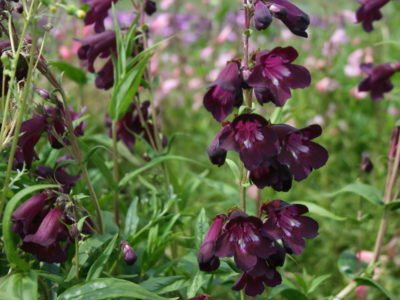

3. Varieties:
3.1.Penstemon digitalis - Penstemon digitalis
Perennial herb 90 - 150 cm high. Leaves are green, oblong, spear-shaped, up to 15 cm long. Peduncles have small, opposite, lanceolate leaves with a finely toothed margin. The flowers are white, bell-shaped, about 2 cm in diameter, collected in loose inflorescences - panicles at the tops of vertical stems. On the outside, the flower petals are slightly pubescent.
↑ Up,
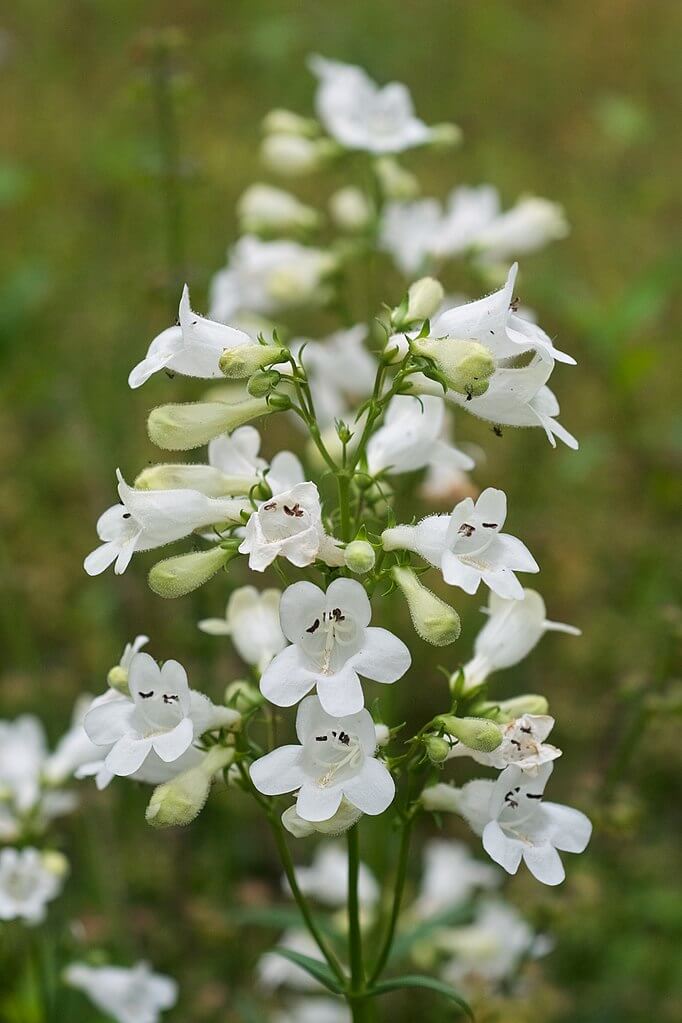

3.2. Penstemon bearded - Penstemon barbatus
A relatively compact variety, ranging in height from 60 to 90 cm. A perennial herb with tough, erect stems, profusely branched at the base. Leaves are linear, narrow, dark green, sessile. Leaf blades are entire, slightly bent along the central vein. The flowers are tubular, collected in loose panicles, pink, coral or red, with 5 rounded, fused petals.
↑ Up,
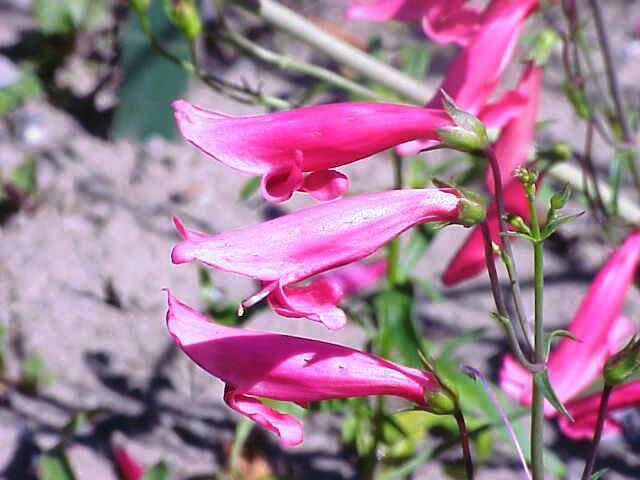

3.3 Penstemon Hartwegii
Perennial herb up to 70 - 80 cm high. Stems are erect, branch abundantly at the base, bear spear-shaped, green, glossy leaves. In the upper part of the stems at the beginning of summer, very bright, attractive, bell-shaped flowers appear in shades of lilac, red, pink. The center of the flowers is white.
↑ Up,


3.4 Penstemon Cobo - Penstemon cobaea
Herbaceous plants with branching vertical shoots reaching a height of 30 - 60 cm. Each bush is capable of forming 15 - 20 peduncles. Leaves are green, spear-shaped, covered with slight pubescence. The flowers are bell-shaped, pink, lilac, purple, white.
↑ Up,
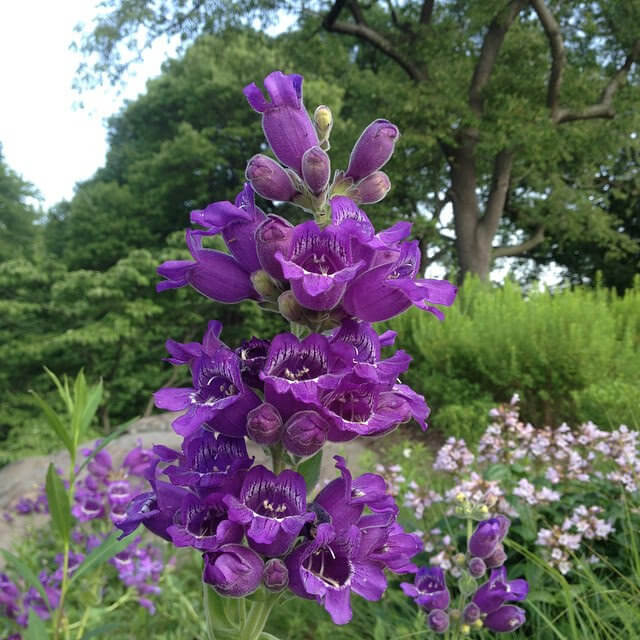

3.5. Penstemon hard-haired - Penstemon hirsutus
Compact herbaceous perennial, reaching 40 - 60 cm in height. Stems are strong, erect, covered with slight pubescence. Leaves are green, opposite, oblong-spear-shaped, with small denticles along the edge of the leaf plates, sessile. Flowers are tubular, long, appear at the top of the shoots, lilac, white or pink. The inner surface of the petals is often painted in a contrasting white color.
↑ Up,
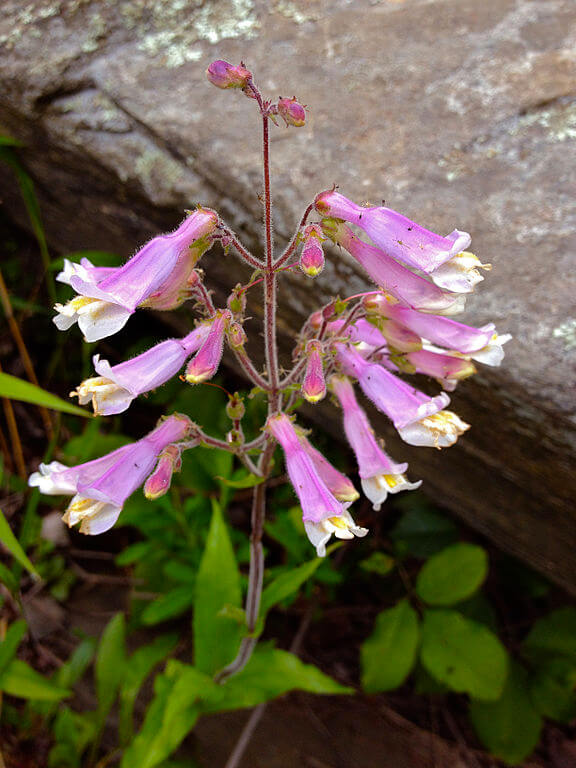

3.6. Penstemon Davidson - Penstemon davidsonii
Low-growing, perennial, ground cover plant with lodging, creeping shoots. Forms dense grassy rugs with age. The leaves are small, juicy, broadly lanceolate or spoon-shaped, green. The flowers are pink, lilac or purple, tubular, abundantly cover the plants.
↑ Up,


Using penstemon in garden design
The advantages of penstemons are in bright exotic flowers and long flowering. Therefore, these plants are best used where they are well visible. Annual and tall perennial species look good in solitary plantings in groups. In mixborders, they go well with cuffs, echinacea, garden geraniums, carnations, catnip, sage, mountaineers, thyme, sedum, Byzantine purse, Louisiana wormwood, duchenea, decorative strawberries, variegated moth and other cereals.


Compact annuals will fit well into flower beds. Low-growing species can be planted in curbs and edging paths with them. Drought resistance makes it possible to successfully use penstemons as container plants. Mountain species and undersized varieties will become the highlight of a rock garden or gravel garden, decorate a sunny slope or retaining wall. Plants are melliferous, attract numerous pollinators to the garden
LiveJournal
Care rules
Growing penstemons is a simple process. Of course, they like to be treated with care, but not picky. It is very important to take care of the drainage system when planting. Highly it is important to ensure that there is no stagnant water
because it is very harmful to the culture. Even winter frosts do less damage than excess moisture. And also, the root system should not be allowed to dry out. During dry periods, watering should be regular. To avoid problems with soil moisture, its surface can be mulched.
Those parts that dry up should be removed. It is also recommended to loosen the soil around the bushes.
Before the onset of frost, you should take special care of the flower. The ground part of the bushes should be cut off. Cut it when the penstemon has finished flowering and shed all the leaves.Cover it with a layer of spruce branches or fallen leaves, while making the thickness of the shelter about 15 cm.
Fertilizing a flower is often not required
... This is usually done when planting seedlings or cuttings. In this case, rotted organic matter is used. This feeding can be done three times per season. Mineral complex fertilizers can be fed to the plant before the beginning of the flowering period. It is desirable that the composition contains an increased content of phosphorus - this will make the flowers even more beautiful.
Growing features
Like most perennials, penstemone is picky about care
and growth conditions. For him, you must observe the following rules:
- The growing area should be well lit, possibly with a little shade in the afternoon.
- The location should be on a hill so that sediments do not accumulate on the flower bed, as this can lead to root rot.
- The soil needs neutral or slightly acidic, nutritious, loose and well-drained (sandy loam, loam, a mixture of black soil and river sand).
- The density of plantings must provide at least thirty-five centimeters between the bushes, otherwise the plants will be weak and may be affected by fungal diseases.
- Regular watering in the evening - once every two days, in case of drought - daily, during the rainy season you do not need to water.
- Mature shrubs should be pruned regularly after flowering.
- Top dressing is performed every three weeks with complex fertilizer.
- Pruning and shelter for the winter is imperative, since the root system without shelter can only withstand up to minus ten degrees Celsius.
Types of penstemon: photo
Blooming penstemon
The flowering time of the plant falls in June and can last both until the end of summer and until the first frost. Everything will depend on the variety. Flowers in a culture can look like bells or snapdragons.
Mostly, the buds are collected in dense large brushes of white, pink, blue, red, purple, orange, yellow shades, and there are also varieties with two-tone colors. After flowering, seeds begin to form, which are used to multiply the culture.
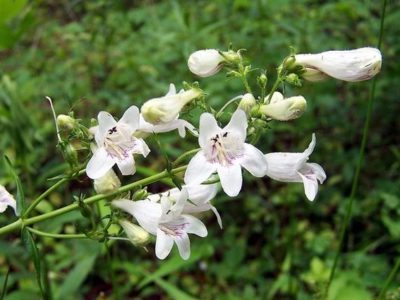

Choosing a suitable site
To plant a light-loving penstemon, select a site in the bright sun. Bushes fall apart from strong gusts of wind and drafts, so plant in a secluded place.
Qualitative characteristics of the soil: looseness, drainage, acidic reaction. Cultivated garden soil filled with rotted manure for deep digging is suitable. Be sure to dilute the loam with coarse sand. We lay the indicated ingredients on the site for a month of planting seedlings or sowing seeds.
Note that the root system of penstemon is afraid of getting wet, so lowlands and areas flooded with melt water are categorically unsuitable for planting it.
Care
Penstemon, planting and caring for which is not fundamentally different from other perennial plants, the most important thing is to provide him with good drainage. The plant requires a careful attitude, although it is not picky. It is important to ensure that there is no stagnant water near the roots, which is very dangerous for penstemon. Watering must be carried out systematically, and special control over this must be in drought. The drying out of their root system will negatively affect the condition of the flower. To maintain a balance between moisture and dryness, you can mulch the soil near the roots of the plant. Part of caring for a penstemon is cleaning up dried parts of the plant and loosening the soil near the bush itself.
The plant meets the wintering process by cutting off all ground parts. All that remains of the plant must be covered with spruce branches or leaves.


Another important detail is the fertilization under the plant. It is best to fertilize penstemon three times during the active period of its growth and development.The most favorable are organic and mineral fertilizers. If the plant is going to bloom, you can help it by introducing drugs with phosphorus, which will help the plant bloom more luxuriantly and the flowers will become brighter.
Growing from seeds
Growing a penstemone from seeds is time consuming, but you will love the result. For good germination, planting material is kept for at least 30 days in a cool place. This could be a balcony or a shelf in the refrigerator for vegetables. Seeds are usually sown early enough; they are usually not soaked before planting. Experienced summer residents will tell you when to plant a plant - in the last decade of February or early spring. Seedlings are obtained from the seeds, which are later planted in open ground.
The soil is prepared lightweight: a mixture of soil, peat and sand. Be sure to use drainage, for example, expanded clay or gravel. The root system of penstemon is very fond of air exchange. It is necessary to sow correctly like this: the soil is moistened, the planting material is pressed into the soil, a thin 2-3 mm layer of sand is poured on top. To insulate penstemon, glass is placed on top of the container or covered with foil. This creates comfortable temperature conditions and good humidity.
Plants will sprout in 1-2 weeks. The container with them needs to be ventilated more often, taken out to the veranda or balcony. Seedlings are best grown at a temperature of 15 degrees. As for vegetable crops, it is better to dive the plants by transplanting them into plastic disposable cups. They should be filled with soil mixture with peat in the phase of 2-3 leaves, that is, early enough. At the end of spring, the seedlings are planted in open ground, in the summer you will get a bright original penstemon bloom.
Seedlings are planted sparsely, remember this, because the adult flower is quite large. Try to maintain a 0.3 meter spacing.
Views
The most common types of penstemon plants for our climate are:
- Alpine Penstemon - its flowers are yellow-lilac in color, while the throat is white. The inflorescences have an umbrella structure, and are located tightly to each other.
- Penstemon bearded - this plant can grow up to a meter in height. It blooms with a red or pink tint. The flowers themselves are similar in appearance to a bell.
- Bell penstemon - can reach a height from half a meter to a meter. The flower resembles bells, which is reflected in the very name of the plant. The color of the petals is lilac, maybe with a pink tint.
- Penstemon foxglove - according to its anthropometric data, this variety does not differ significantly from the previous variety. Penstemon flowers of this variety are most often white or pale pink.
Fertilizer for penstemon
The first feed is mixed into the soil as compost when the young are planted. Organic fertilizers are applied under the bushes three times a season.
Before flowering crops, experienced gardeners recommend using a complex mineral dressing with a high phosphorus content. With its help, you can enhance flowering and affect the decorative characteristics of flowers.
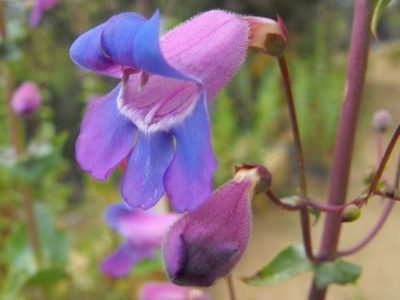

Features of penstemon


From Latin the name "penstemon" is translated as "almost a stamen". The fact is that the flower of this plant has only one stamen of an unusual shape, it is sterile and very long, due to which it protrudes far beyond the petals. The British call this plant "bearded tongue". Gardeners rarely grow such a flower in middle latitudes. But every year the popularity of this culture is growing, thanks to its unusual shape, long flowering and beautiful foliage. Flowers appear on the bushes in the first days of June, and the duration of flowering can vary from 2 to 3 months. It is quite easy to grow such a culture in your garden, but this is only if you select the right site for it and provide it with the right care.
Vegetative propagation of penstemon
Large penstemon bushes can be divided.We dig it in the spring, disconnect it into several parts with a piece of rhizome and shoots, we plant it in holes at a distance of 35 cm from each other.


Penstemon from cuttings photo
In the period May-August we are engaged in cuttings. We cut off the tops of the shoots, plant them in containers with wet sand and root them in diffused lighting, covering each stalk with a cut plastic bottle or glass jar. Air daily, do not forget to moisten the soil, when signs of growth appear, transplant to a flower bed.
Penstemon is also propagated by layering. Start the process in the spring: it is easy to bend the herbaceous shoot to the ground, you just need to fix it with a bracket, sprinkle with a handful of damp earth in the place of contact with the soil and water, the top should remain on the surface. The formation of the root system and young shoot lasts 2-3 weeks, after which it can be separated from the mother plant and planted separately.

